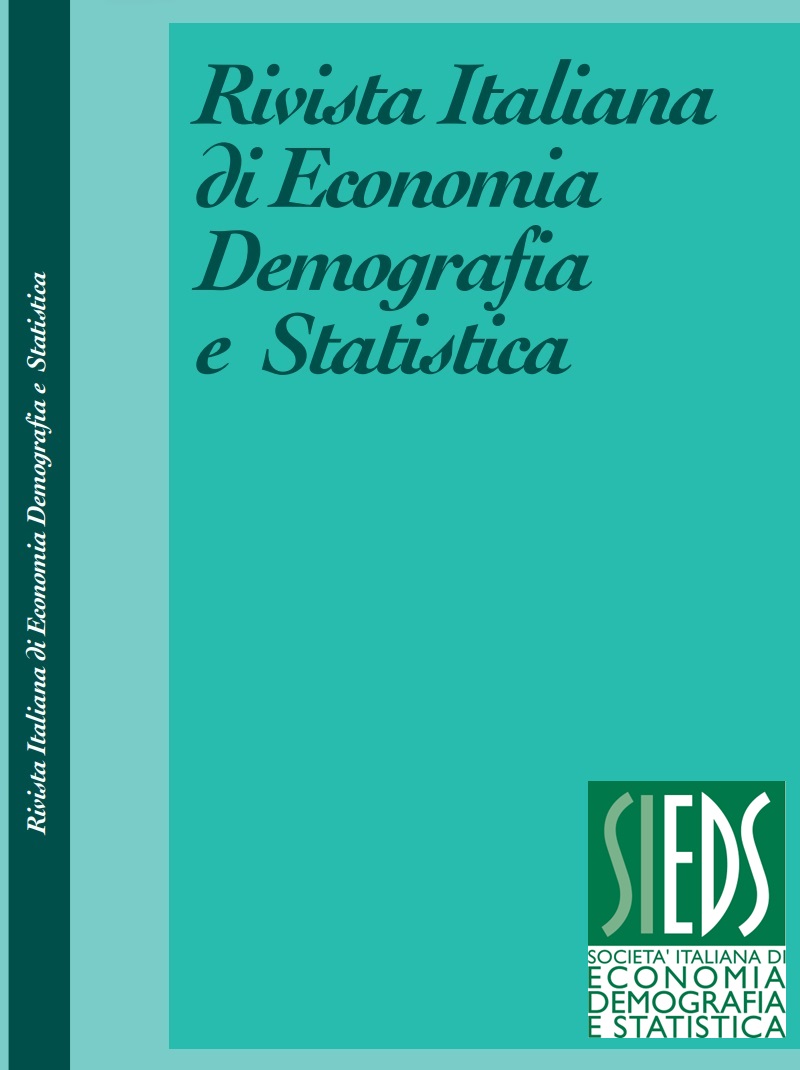Tracing Demographic Events Through the Seasons in 18th and 19th Century Bologna
DOI:
https://doi.org/10.71014/sieds.v78i3.365Keywords:
Birth Seasonality, Historical Demography, Meteorological Impact, Regression Analysis, Pre-Industrial ItalyAbstract
This study explores the seasonality of demographic events, focusing on birth seasonality in Bologna from 1729 to 1860. Utilizing monthly data series, the research investigates the impact of meteorological conditions, specifically rainfall and temperature, on birth trends. The analysis employs Henry's seasonality indicators and OLS regression models to examine the effects of lagged precipitation and temperature on birth rates. The findings reveal a consistent pattern of birth seasonality, with births peaking in the early months of the year and declining in summer. The study concludes that weather conditions had a significant, albeit modest, impact on birth seasonality, highlighting the historical interplay between environmental factors and demographic trends in pre-transition settings.
References
BARONI U., 1964. La periodicità delle nascite lungo il secolo delle rilevazioni demografiche in Italia (1862–1962), Rivista Italiana di Economia, Demografia e Statistica, Vol. 18, No. 3-4, pp.151-174.
BARRECA A., DESCHENES O., GULDI M. 2018. Maybe Next Month? Temperature Shocks and Dynamic Adjustments in Birth Rates, Demography, Vol. 55, No. 4, pp. 1269–1293. DOI: https://doi.org/10.1007/s13524-018-0690-7
BELLETTINI A. 1961. La popolazione di Bologna dal secolo XV all’Unificazione Italiana. Bologna: Zanichelli Editore.
BONNEUIL N., FURSA E., 2018. Optimal seasonality of conception inferred from monthly marriage and birth time series in populations with no contraception, Mathematical Methods in The Applied Sciences, Vol. 41, No. 3, pp. 1125-1135. DOI: https://doi.org/10.1002/mma.4364
CRISAFULLI C., DALLA ZUANNA G., SOLERO F., 2000. La stagionalità delle nascite di ancien régime nelle provincie italiane e in Calabria, Popolazione e Storia, Vol. 1, No. 1-2, pp. 177-198.
CUMMINGS D.R., 2002. The seasonality of human births, melatonin and cloud cover, Biological Rhythm Research, Vol. 33, No. 5, pp. 521–559. DOI: https://doi.org/10.1076/brhm.33.5.521.13938
CUMMINGS D.R., 2007. Additional confirmation for the effect of environmental light intensity on the seasonality of human conceptions, Journal of Biosocial Science, Vol. 39, No. 3, pp. 383–396. DOI: https://doi.org/10.1017/S0021932006001568
CUMMINGS D.R., 2010. Human birth seasonality and sunshine, American Journal of Human Biology, Vol. 22, No. 3, pp. 316–324. DOI: https://doi.org/10.1002/ajhb.20987
GONZÁLEZ-MARTÍN A., 2008. Ecological and cultural pressure on marriage seasonality in the Principality of Andorra, Journal of Biosocial Science, Vol. 40, No. 1, pp. 1–18. DOI: https://doi.org/10.1017/S0021932007002234
KERTZER, D.I., HOGAN, D.P. 1989. Family, political economy, and demographic change: The transformation of life in Casalecchio, Italy, 1861–1921, Chicago: University of Wisconsin Press.
LAM D., A., MIRON J. A., 1996. The effect of temperature on human fertility, Demography, Vol. 33, No. 3, pp. 291–306. DOI: https://doi.org/10.2307/2061762
LAM D., A., MIRON J. A., RILEY A., 1994. Modeling seasonality in fecundability, conceptions, and births, Demography, Vol. 31, No. 2, pp. 321–346. DOI: https://doi.org/10.2307/2061888
RETTAROLI R., SCALONE F., 2012. Reproductive Behavior during the Pre-Transitional Period: Evidence from Rural Bologna, Journal of Interdisciplinary History, Vol. 42, No. 4, pp. 615-643. DOI: https://doi.org/10.1162/JINH_a_00307
RUIU G.A., 2017. "Per ogni cosa c’è il suo momento...". La stagionalità dei decessi in Sardegna (1862-2014), Popolazione e Storia, Vol. 18, No. 2, pp. 53-73.
RUIU G., BRESCHI M., 2017. Seasonality of livebirths and climatic factors in Italian regions (1863-1933), Historical Life Course Studies, Vol. 4, No.1, pp. 145-164. DOI: https://doi.org/10.51964/hlcs9342
RUIU G., BRESCHI M., 2020. Intensity of Agricultural Workload and the Seasonality of Births in Italy, European Journal of Population, Vol. 36, No.1, pp. 141-169. DOI: https://doi.org/10.1007/s10680-019-09524-1
SCALONE, F., AGATI, P., ANGELI, A., DONNO, A. 2017. Exploring unobserved heterogeneity in perinatal and neonatal mortality risks: The case of an Italian sharecropping community, 1900–39, Population Studies, Vol. 71, No. 1, pp. 23-41. DOI: https://doi.org/10.1080/00324728.2016.1254812
SCALONE F., SAMOGGIA A., 2018. Neonatal mortality, cold weather, and socioeconomic status in two northern Italian rural parishes, 1820–1900, Demographic Research, Vol. 39, No. 18, pp. 525-560. DOI: https://doi.org/10.4054/DemRes.2018.39.18
STOCK J.H., WATSON M.W. 2007. Introduction to Econometrics. New York: Pearson Addison Wesley.
Downloads
Published
Issue
Section
License
Copyright (c) 2024 Nadia Barbieri, Hassan Rahnaward Ghulami, Rosella Rettaroli, Francesco Scalone

This work is licensed under a Creative Commons Attribution 4.0 International License.



